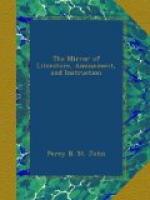[Illustration: (Study.)]
ROKEBY, AND MINOR POEMS.
After the publication of the Lady of the Lake, Sir Walter’s poetical reputation began to wane. In 1811, appeared Don Roderick; and in 1813, Rokeby; both of which were unsuccessful; and the Lord of the Isles followed with no better fortune. In short, Sir Walter perceived that the tide of popularity was turning, and he wisely changed with the public taste. The subjects of these poems were neither so striking, nor the versification so attractive, as in his earlier poems. The poet himself attributes their failure to the manner or style losing its charms of novelty, and the harmony becoming tiresome and ordinary; his measure and manner were imitated by other writers, and, above all Byron had just appeared as a serious candidate in the first canto of Childe Harold; so that Sir Walter with exemplary candour confesses that “the original inventor and his invention must have fallen into contempt, if he had not found out another road to public favour.” We shall therefore now part with his poetic fame, and proceed in the more gratifying task of glancing at his splendid successes in prose fiction.
WAVERLEY.
The first of the author’s
long trails of light descending down,
had its origin in a desire to story the ancient traditions and noble spirit of the Highlands, aided by the author’s early recollections of their scenery and customs; in short, to effect in prose what he had so triumphantly achieved in the poem of the Lady of the Lake. The author’s own account will be read with interest:—“It was with some idea of this kind, that, about the year 1805, I threw together about one-third part of the first volume of Waverley. It was advertised to be published by the late Mr. John Ballantyne, under the name of ‘Waverley,’ or ’’Tis Fifty Years since,’—a title afterwards altered to ‘’Tis Sixty Years since,’ that the actual date of publication might be made to correspond with the period in which the scene was laid. Having proceeded as far, I think, as the seventh chapter, I showed my work to a critical friend, whose opinion was unfavourable, and having some poetical reputation, I was unwilling to risk the loss of it by attempting a new style of composition. I therefore




